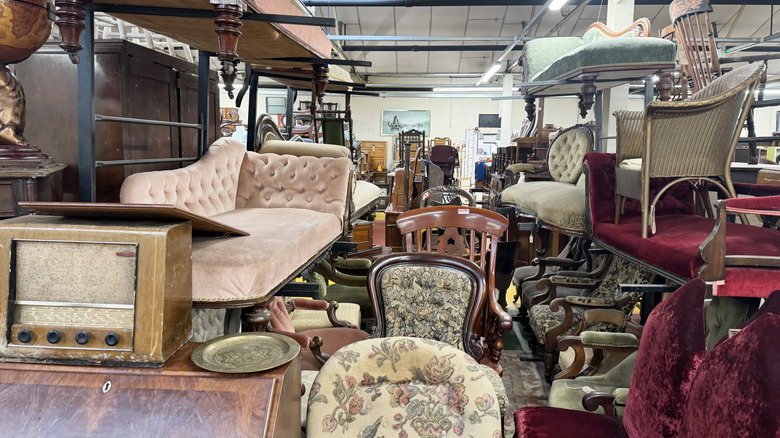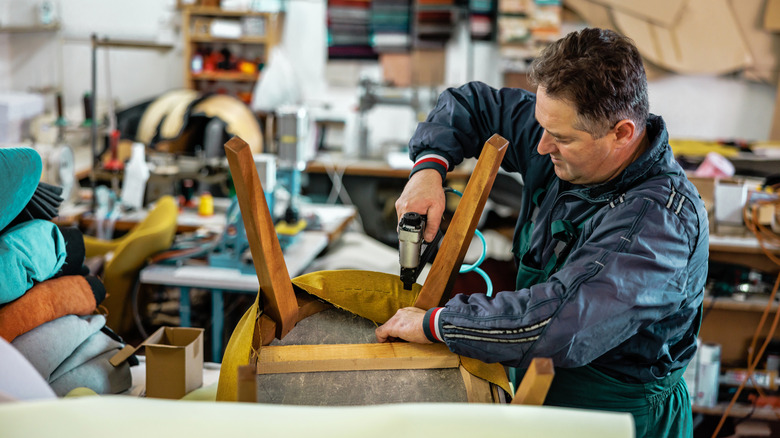The Downside To Thrifting Antique Upholstered Furniture That No One Ever Tells You
Couches, ottomans, chairs, and other bigger furniture options can be pricey, so it makes sense that secondhand shops are a hot stop. While there, you'll come across many vintage pieces that come in different shapes, sizes, and fabrics, making it easy to find a solid item for your home while saving money at the same time. But before buying antique furniture for your home, there is one major pitfall that you need to be aware of, especially when it comes to older renditions covered in fabric. The downside to thrifting antique upholstered furniture that no one ever tells you is that apart from the cost on the price tag, you might also have to fork out a substantial amount for the replacement or repair of the fabric, and the upholstering services.
In general, upholstered furniture pieces have a fabric or leather covering with padding, and normally springs on the inside. They are usually added to a home for comfort, but can also bring warmth, elegance, and personality. They typically need more upkeep and cleaning compared to non-upholstered vintage furniture, but with the right care, the pieces can last you many years. While reupholstering costs can be a significant downside, that doesn't mean there are not ways to curb high prices while still being able to hit the resale shop to find your next thrifted antique treasure. To that end, you need to look for sturdy, clean picks and find affordable yet durable fabric replacement options.
Breaking down the costs for restoring antique upholstered furniture
Before you snap up that unique piece of furniture at your local thrift store, you'll need to consider all the costs associated with restoring the piece so it looks great in your home. The first step on the price journey of an old-fashioned furniture item is the price tag. While this might seem like an absolute bargain, don't just stop there because the other elements needed for finishing, may add a substantial amount to that cost.
As you're choosing upholstery fabric, you'll find that prices may vary quite considerably, especially if you're after a more classic style. To add to that, some furniture pieces with worn upholstery may even need extra care and maintenance, like professional steam cleaning or spraying for pests. You also have to account for any other repairs that are the result of structural or framing issues. These can be quite pricey considering some of the original materials used, like hay, seaweed, and horsehair, although the upholsterer can use alternatives, unless you're really keen to keep the authenticity of the piece in tact.
You also can't forget about the costs that come with the reupholstering itself, whether that be through a professional service, or the time that you put in if you're planning to do it yourself. While the easiest route is to work with a professional, you have to add on their labor costs, which could range from $40 to $100 per hour. So, given that the average chair can take up to 14 hours to reupholster, you could end up paying anywhere from $600 to $1400 for the work.
Ways you can minimize the added costs
Before you make any kind of furniture purchase, you need to assess the overall condition of the vintage piece you've found. The one exception to avoiding upholstered items at the thrift store is to find furniture pieces with good bones. Look at the overall structure of the piece to make sure there are no damages, foul odors, or excessive wobbliness. Look for upholstered scores with quality wood or metal frames, and try to avoid options that have stains and other issues that aren't worth your money and time to fix.
Thrifted antique upholstered scores can be restored in a budget-friendly way, if you can find affordable and durable fabric replacements. While you can use traditional options, modern fabrics, like polyester blends and microfiber, will keep you within budget. Polyester blends, which include those mixed with cotton, have an excellent balance between strength and comfort. Microfiber, on the other hand, is a popular choice because of its stain-resistant properties. Finally, if you have the time and enthusiasm, you might be able to find some reupholstering classes in your local area or follow a few tutorials online. These may allow you to complete the restoration yourself, and avoid the cost of using a professional.


